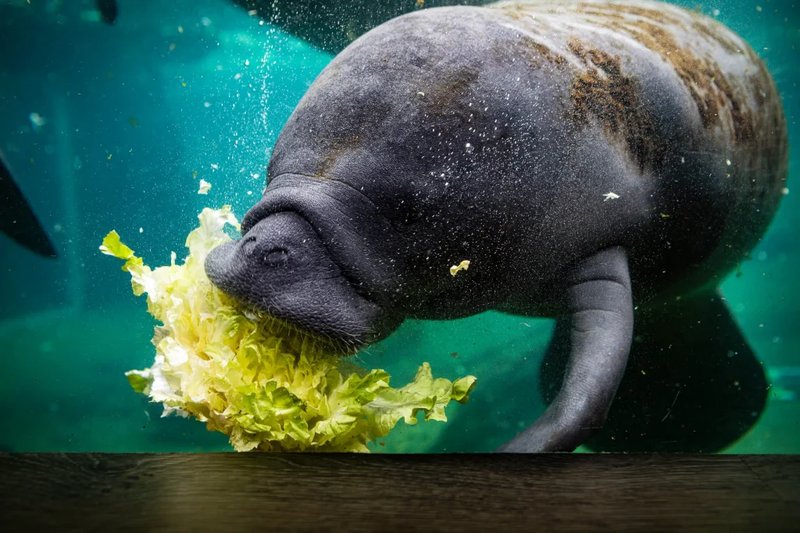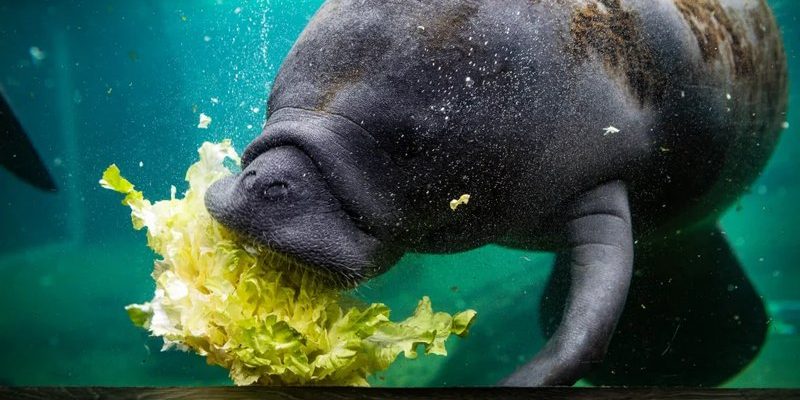
These large mammals are primarily known for their *herbivorous* diet. Imagine a big, friendly cow, but instead of grazing on grass in a green pasture, a manatee grazes on underwater vegetation in rivers and coastal areas. That’s the essence of a manatee’s daily routine—slow, peaceful, and crucial for both their survival and the health of their habitat. So, what exactly do they eat, and how do they get their meals? We’ll explore that and more!
What Do Manatees Eat?
Manatees are strict herbivores, which means their diet is almost exclusively made up of aquatic plants. They enjoy a variety of vegetation, including:
- Seagrasses
- Algae
- Water hyacinths
- Other submerged aquatic plants
Here’s the thing: manatees are quite picky eaters despite their size! They tend to gravitate towards certain types of seagrass, depending on availability and season. In shallow waters, they can dive down and graze for hours, sometimes consuming up to 10% of their body weight in a day, which can be around 100 pounds! That’s like eating a small car’s worth of food without a single fast-food joint in sight!
Interestingly, manatees also have a taste for fresh water. They often munch on plants found in brackish environments and can be seen venturing into rivers, lakes, and estuaries where these plants grow. By doing this, they play a vital role in maintaining the health of these ecosystems.
Feeding Behavior of Manatees
Manatees have unique feeding behaviors that help them find and consume their preferred plants. They use their powerful lips to grasp and pull up aquatic vegetation. It’s almost like watching a toddler pick flowers—slow, deliberate, and with a bit of curiosity!
The *manatee’s lips* are not just any ordinary lips; they are highly specialized. They have sensitive bristles called vibrissae that help them feel around in murky waters, which is super helpful since visibility can often be low. This tactile sensation lets them locate plants even if they can’t see them clearly, making feeding more efficient.
Additionally, manatees have a habit of *grazing* in groups, a behavior that not only helps them feed but also fosters social bonds. Seeing a group of manatees munching together can be quite a sight, almost like a family picnic but underwater!
How Much Do Manatees Eat?
You might be wondering just how much a manatee eats in a day. These gentle giants have huge appetites! On average, a single manatee can eat between 100 to 150 pounds of vegetation daily. That’s like a teenager devouring an entire pizza on their own!
This hefty diet helps maintain their energy needs, especially since manatees are slow-moving creatures. They need plenty of calories to sustain their bodies. Since they are mammals, they have a relatively low metabolic rate, so they take things easy. Consequently, their feeding habits are crucial because they ensure they’re getting enough food to stay healthy while supporting the environment around them.
The Role of Manatees in Their Ecosystem
Manatees don’t just munch for themselves; they play a huge role in the health of their habitat. As they graze on seagrasses and other aquatic plants, they help control plant growth, allowing for biodiversity to flourish. When they trim the vegetation, they promote new growth, which is vital for the entire ecosystem.
This grazing behavior also creates habitats for other marine animals. For example, when manatees eat seagrass, they help maintain the right environment for fish and invertebrates. Think of them as nature’s lawnmowers, ensuring that everything stays in balance. Without them, we could see overgrowth of certain types of plants, which could lead to less oxygen in the water and harm other species.
Seasonal Changes in Manatee Diet
Believe it or not, manatees’ diets can change with the seasons. During warmer months, they have a broader variety of plants to choose from since seagrasses bloom abundantly. However, as temperatures drop, manatees tend to migrate to warmer waters where they can find their favorite food sources more easily.
During winter, when the water gets chilly, manatees often congregate near natural springs or power plant discharges that provide warmer water, along with an ample supply of food. It’s fascinating how these gentle giants adapt their feeding habits based on temperature and availability. They essentially become experts at knowing where to go for a warm meal!
How Do Manatees Find Food?
Manatees have a few tricks up their sleeves when it comes to locating their food. As mentioned earlier, their sensitive lips and whiskers help them feel around for plants. But they also have a keen sense of smell. Yes, that’s right—these big animals have an excellent nose!
When looking for food, they often rely on their sense of smell to detect underwater vegetation. Once they locate a spot with tasty plants, they dive down and begin their meal. It’s like a gourmet restaurant experience, but they don’t have to make a reservation!
Interestingly, manatees will often revisit areas where they’ve previously found food. This habit shows they have a memory for their favorite spots, which helps them thrive in their environments as they can effectively retrace their steps to find meals again.
Challenges in the Manatee Diet
While manatees are generally well-suited to their diets and eating habits, they face challenges that can affect their food sources. Pollution, habitat loss, and climate change can significantly impact their food availability. For instance, when waterways become polluted, aquatic plants can die off, leaving manatees with fewer options for their meals.
Additionally, the destruction of seagrass beds due to boat traffic or coastal development can lead to food shortages for these gentle creatures. Without adequate food sources, their health and population will decline. Conservation efforts have seen a lot of focus on protecting their habitats, ensuring they have access to the nutritious plants they need.
In conclusion, the diet and feeding habits of manatees are not just fascinating but also crucial for the balance of their ecosystem. By understanding how these creatures eat, where they find their food, and the challenges they face, we can better appreciate their role in our waterways. So the next time you think of manatees, remember—they’re not just munching away; they’re doing their part to keep the aquatic world healthy and thriving!

